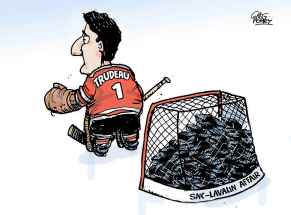When budget gets cut, wait times go up
Read this article for free:
or
Already have an account? Log in here »
To continue reading, please subscribe:
Monthly Digital Subscription
$0 for the first 4 weeks*
- Enjoy unlimited reading on winnipegfreepress.com
- Read the E-Edition, our digital replica newspaper
- Access News Break, our award-winning app
- Play interactive puzzles
*No charge for 4 weeks then price increases to the regular rate of $19.00 plus GST every four weeks. Offer available to new and qualified returning subscribers only. Cancel any time.
Monthly Digital Subscription
$4.75/week*
- Enjoy unlimited reading on winnipegfreepress.com
- Read the E-Edition, our digital replica newspaper
- Access News Break, our award-winning app
- Play interactive puzzles
*Billed as $19 plus GST every four weeks. Cancel any time.
To continue reading, please subscribe:
Add Free Press access to your Brandon Sun subscription for only an additional
$1 for the first 4 weeks*
*Your next subscription payment will increase by $1.00 and you will be charged $16.99 plus GST for four weeks. After four weeks, your payment will increase to $23.99 plus GST every four weeks.
Read unlimited articles for free today:
or
Already have an account? Log in here »
Hey there, time traveller!
This article was published 28/03/2019 (2455 days ago), so information in it may no longer be current.
Each and every year following the release of the provincial budget, Premier Brian Pallister will remind Manitobans that his government is spending more on health care now than any other government in the history of the province. And he is not wrong.
Health care spending is expected to be higher this year than any previous year under any government. However, that metric only tells part of the story of health expenditures in Manitoba. To get to the truth, you have to look at key indicators such as the number of priority surgical procedures — hip and knee replacements, and cataract surgeries — that the health system performs each year.
In the most recent report from the Canadian Institute for Health Information (CIHI) on priority surgical procedures, the province has fallen farther behind on hip and knee replacements and cataract surgeries. Manitoba has had among the longest waits in the country for these procedures; over the last three years of Tory government, the situation has become even worse.
Fewer than half of all Manitobans requiring a hip replacement, and only about a third requiring a knee replacement, are getting them within the national standard of six months. Less than one-third (29 per cent) of Manitobans who need cataract surgery get it inside the standard of 16 weeks.
Of greater concern, Manitoba’s performance in those critical areas has worsened in the past three years.
CIHI did identify those areas where Manitoba meets or exceeds national benchmarks, such as for the treatment of hip fractures and radiation therapy for cancer patients. Manitoba also made meaningful improvements in wait times for MRIs. These are areas where, historically, Manitoba has always ranked near the very top of all provinces.
How did we lose so much ground in hips, knees and cataracts? It’s simple economics, really.
The province’s austerity strategy has forced it to cut or freeze spending in almost every department of government. The effect of that austerity is difficult to spot in some departments. In health, there are so many tools to measure outcomes that the consequences of this strategy are easy to spot.

In health, the impact of austerity is pretty stark.
In 2016-17, the first year the Tories were in power, spending on health care topped out at 6.546 billion, an increase of $309 million over what the former NDP government had spent the previous year. However, in 2017-18, the first full year that the Tories had their hands on the fiscal levers of government, austerity set in.
Total spending in 2017-18 was $6.483 billion, $198 million less than budgeted and $42 million less than it spent a year earlier. It was the first time since the 1990s that health care spending had ever been less year over year.
The final numbers are not in yet for 2018-19 — public accounts for that fiscal year won’t be tabled until early fall — but Health Minister Cameron Friesen has already suggested that expenditures in his department may come in at $240 million less than budgeted. Friesen said half of that amount is due to a change in accounting procedures at the regional health authorities but that still leaves the province $120 million under budget.

How concerned are the Tories about this record of austerity? The spin machine is working overtime to try to downplay the underspending and amplify those areas where there has been increased capacity.
In the news release from Friesen on the CIHI report, he highlighted the positive results in wait times for MRIs, CTs and hip fracture repairs. He also noted a one-time $5-million increase in funding for hips, knees and cataracts in 2019, announced last November, six months before the 2019-20 budget was tabled.
You have to get down to the fifth paragraph before you read anything about what the province calls “suboptimal” wait times for hips, knees and cataracts. In the news business, we call that “burying the lede.”
The one-time increase in funding for these priority procedures is, of course, welcomed. However, it does not help all of the patients who were forced to wait even longer for hips, knees and cataract surgeries, many of whom are older and have less capacity to endure delays.
The worst part of this story is the refusal of the Pallister government to admit what is going on.
Pallister inherited a government mired in deficit financing. Thanks to his relentless attention to detail on fiscal oversight, every penny is being scrutinized in ways unheard of in Manitoba. That has produced a significant reduction in the annual deficit, a worthy accomplishment.
Pallister has also kept his promise to reduce the PST back to seven per cent before balancing the budget. Everyone loves a tax cut, of course, but this one comes with a cost.
Cutting the PST will cost the treasury $330 million annually in lost revenue. This is a key point: Pallister decided to forgo all that revenue at a time when he and his government knew it was still in deficit and falling farther behind on priority surgical procedures.
The cause (austerity on expenditures, tax cuts) leads us to the effect (longer waits for surgery).
If the premier or his health minister were willing to admit to the real cost of the PST cut — at least in terms of hips, knees and cataracts — then Manitobans could make an informed decision about whether the government they elected with a thunderous majority in 2016 was delivering on what they promised. But the Pallister government won’t admit that.
So, that leaves voters in the next provincial election to connect the dots on their own. Heaven help the Tories if they figure it out.
dan.lett@freepress.mb.ca

Born and raised in and around Toronto, Dan Lett came to Winnipeg in 1986, less than a year out of journalism school with a lifelong dream to be a newspaper reporter.
Our newsroom depends on a growing audience of readers to power our journalism. If you are not a paid reader, please consider becoming a subscriber.
Our newsroom depends on its audience of readers to power our journalism. Thank you for your support.










